| Pages:
1
2 |
vacaenbaja
Senior Nomad
  
Posts: 643
Registered: 4-4-2006
Member Is Offline
|
|
Las Flores
"They called it Las Flores because it was spring when
they laid out the town. There were wild flowers every-
where covering the ground just like a planted garden.
There had been winter rains. The whole country was
green and in bloom. It hasn't been like that many times
since but I have seen it often enough in the last sixty
years to know what it must have been like."
" It was Dick Daggett speaking. He knew what he was
talking about, for he was born at what max miller once
called the "former ghost town of Las Flores." In fact he
had just shown us a few remaining stones of the foundat-
tion of the big frame house where he lived when his
father was the foreman of the silver and gold mine.
Las Flores lies south and inland about ten miles from
the Diaz establishment. It was the town for the San Juan
Mining Company, which took several millions of dollars
from the burned-looking brown mountain behind it. In
fact, Las Flores was three towns.
"You wouldn't believe it," said Dick, waving his hand
at the cactus-studded brush and sand,"but there was really
a town here with streets and rows of houses--more than
hard to believe now but I saw it--I lived here.
"The little engine there sits at the end of the line. It
used to haul the cars up to the foot of the hill where the
tramway came down. the tramway carried the ore to the
cars, gravity pulled them back down to the mill where we
are standing. You can see where the tracks used to run
from here to the mountain. Those tracks divided the
main parts of the settlement. On this side of the tracks
were the adobe and wood houses of the foremen, assay-
ers, mill men, and other bosses of the place. On the south
side were the brush shacks of the mine laborers. They
were mostly Yaqui Indians. Then, down the hill below
the end of the tracks and far enough away so the noises
wouldn't bother, was the campo libre or free area. Here
were the saloons and the houses where the women
helped the laborers get rid of their money. It was quite a
set-up. The jail, over there, is the only complete building
left today of a settlement that housed over five hundred
workmen and their families plus the camp followers. A
man could go down to the campo libre and get as drunk
as he wanted to but he was supposed to sober up before
he came back to town. If he came back intoxicated, they
threw him in jail and there he stayed until he sobered
up."
We left the picturesque little steam engine and walked
over to the jail. it was built of stonework about eighteen
inches thick. Some of the bars of the windows have been
removed but the heavy iron doors are just as they used to
be. The heavy locks have been carried away in recent years
by curio hunters. The reason this building is still intact is
its stone construction throughout. Even the arched roof
is made of motar and stone.. It is probably the most solid
building in this part of the peninsula.
We walked back to the crumbling adobe walls of the
old mill and Dick told us of the history of the place as we
sat in the welcome shade of one of the higher walls. It
seems that the first man really to work this property was
Henry Krans. He bought the property from Jose Morada
of San Jose California, about 1885. Morada had owned
the mine since 1882 but had not worked it extenssively.
Krans made the property pay almost from the grass roots,
for there was grass on those dry mountains the spring
when he opened things up. He packed ore down the
mountains on mules and shipped it from the beach over
to Guaymas and then by train to the smelter. this, of
course, was picked high-grade ore. When the smelter re-
turnes began coming in, Krans spent them on more equip-
ment and machinery.
About then two things took place which were a big
help to the new venture. First, the old mill of the Santa
Marta Mine was abandoned and Krans bought the tracks
and machinery. Two men from Washington D.C., had
opened the Santa Marta mine some years earlier and
spent two hundred and eighty thousand good American
dollars. When they finally started the mill running they
found the ore would not separate as they had hoped and
the whole thing was a loss.
The other item that helped the new camp, was strange-
ly enough, the end of the Chicago Exposition. When they
tore down this great Worlds Fair, a tremendous amount
of lumber and timber was sold at very low prices. Dick
Dagget's father bought several carloads of this lumber to
build a tramway, put up offices, and establish perma-
nent homes. This lumber was the making of the camp.
Later it was the cause of its destruction, for in an area of
little timber and no sawmills this building material was
again taken away and sold as third-hand lumber all over
the peninsula. It even went to Guaymas and as far north as Ensenada."
PART 2 TO FOLLOW Story by John Hilton
|
|
|
Neal Johns
Super Nomad
   
Posts: 1687
Registered: 10-31-2002
Location: Lytle Creek, CA
Member Is Offline
Mood: In love!
|
|
Thanks, great story.
Neal
My motto:
Never let a Dragon pass by without pulling its tail!
|
|
|
BajaBlanca
Select Nomad
      
Posts: 13242
Registered: 10-28-2008
Location: La Bocana, BCS
Member Is Offline
|
|
very interesting !
|
|
|
Jack Swords
Super Nomad
   
Posts: 1095
Registered: 8-30-2002
Location: Nipomo, CA/La Paz, BCS
Member Is Offline
|
|
Bump...can't wait for part two! Tramway cables are still visible going up the hill.
|
|
|
larryC
Super Nomad
   
Posts: 1499
Registered: 8-11-2008
Location: BoLA
Member Is Offline
|
|
I didn't see much of the cable when I went up there, but a lot of the old ore buckets are still where they came to rest when the cable finally
collapsed.
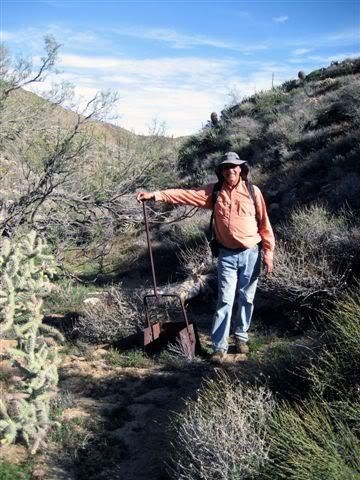
The San Juan mine is a really interesting trip. I was fascinated by all the equipment still up there, large ore carts that probably weigh several
tons. How they got them up there is a mystery to me. Gold mining looks like way too much work to me.
[Edited on 1-4-2012 by larryC]
|
|
|
vacaenbaja
Senior Nomad
  
Posts: 643
Registered: 4-4-2006
Member Is Offline
|
|
This "facts" of this story are a bit dated as this interview occured long ago when Dick Daggett was still alive.
For a more recent view of how things may be now, as
well as comparison of "facts and occurances" see this link.
http://www.discoverbaja.com/pdf/apr09.pdf
PART 2 of story to follow soon.
[Edited on 1-4-2012 by vacaenbaja]
|
|
|
Barry A.
Select Nomad
      
Posts: 10007
Registered: 11-30-2003
Location: Redding, Northern CA
Member Is Offline
Mood: optimistic
|
|
Great thread---------thanks for the very interesting stories. Having passed Las Flores so many times on our trips to Las Animas Bay, I always
wondered about the history behind that place--------this helps a lot!!!
Barry
|
|
|
Santiago
Ultra Nomad
    
Posts: 3540
Registered: 8-27-2003
Member Is Offline
|
|
As a wood guy, I would love to see any of the lumber from the Chicago Expo somewhere in BOLA. Anyone know if some is still about?
|
|
|
vacaenbaja
Senior Nomad
  
Posts: 643
Registered: 4-4-2006
Member Is Offline
|
|
Las Flores PART 2
We asked Dick where his father came in to the picture,
and he answered rather matter of factly: "Oh, he jumped
ship from a British boat that come over with machinery
for the copper mines of Santa Rosalia and the gold mine
of Santa Marta. You can still see the foundations of the
old mill on the cliff above the bay about a mile and a half
south of the Diaz place. That little cave near the road
that runs behind the hill was my father's hiding place.
He hid in there for three days while the captain hunted
for him. Finally the old boy gave up and sailed away with-
out him.
"Once the Captain was very close to my fathers's cave
and seemed to be looking right toward it but it didn't look
like much from below and just about the time my dad
was ready to break and run for it, the captain turned and
went back down the wash. My father had friends ashore
who brought him food and water at night. The Captain
was a very mean man: he had been bad to many of the
sailors on the voyage around the Horn. In Santa Rosalia
the Captain had knocked a young boy down and kicked
him where he lay on the deck. When he stooped over to
pull the boy up so he could knock him down again, my
father, who was a big man, kicked the captain very hard
and sent him sprawling across the deck. This almost
started a mutiny becaause a lot of the sailors hated the
Captain. My father was put below under guard. The Cap-
tain swore he would have him tried and hung in Liver-
pool when he got back from the voyage. He was going to
make an example of him.
"The sailors liked my father so much better than the
Captain that they saw to it that he escaped after the Cap-
tain went ashore at Angelitos to talk to the mining men
about unloading. Then some of my father's friends told
people at the mine about him and they showed him
where to hide and brought him food. That's how the Dag-
getts came to Baja California."
Dick's father worked for the Santa Marta Mining Com-
pany until it quit working, and then he had a great
deal of experience and had made a good many friends.
He was soon made foreman of the Las Flores Mill. He
continued in this capacity until the death of Mr. Krans,
which was about tweleve years later. During this time the
mine paid its own way, supported a good-sized commun-
ity, and netted about two million dollars for the owner
from an original investment of about ten thousand.
Dick explained that this was not the general history of
mines in Baja California. Most of them cost the owners
more than the gold that was produced, except the placers
in the far north and around Campo Aleman and one
other large quartz mine in the south.
Dick is not certain when his father married his mother
but it must have been shortly after he moved to Las
Flores. His mother was one of the Reyes girls from the
south. Dick does not remember her very well for she died
shortly after his sister was born. He recalls that she was
rather frail and sick a good deal of the time. Two aunts
came to Las Flores and took care of their ailing sister and
the two children. Dick's mother was only twenty-six
when she passed away.
"I'll take you over and show you her grave," he said as
he rose with a spryness that made it hard for us to believe
that he was born in this deserted town in 1893. The group
of us arose and followed. The four of our family and Bob
Noonan had driven out with Dick that morning and we
had all sat quietly as this man, who has often been called
the Mayor of the Bahia de los Angeles, explained the his-
tory of the "former ghost town of Las Flores."
"There's another graveyard on the other side of the
tracks," Dick explained over his shoulder. "Even in death
the two camps were separated."
We picked our way gingerly amoung thorny bushes and
thornier cholla cacti. Here and there we coould see bits of
stone and adobe still clinging together enough to tell that
once a house had stood there. In one area Dick kicked
around in the sand and uncovered some old crucibles
green with melted slag. "Here is where the assay office
stood," he said. "That pile of firebrick back of those
bushes came out of the furnace. When they sold out the
camp, they even sold all of the good firebrick. Only the
broken ones are left."
Story by John Hilton
PART 3 TO FOLLOW
|
|
|
Paulina
Ultra Nomad
    
Posts: 3812
Registered: 8-31-2002
Location: BCN
Member Is Offline
|
|
| Quote: | Originally posted by vacaenbaja...
"There's another graveyard on the other side of the
tracks," Dick explained over his shoulder. "Even in death
the two camps were separated."
|
YES! I was so excited to read this part. I found that other graveyard in 1981 and haven't been able to find it since. I was beginning to think that I
imagined it.
P>*)))>{
\"Well behaved women rarely make history.\" Laurel Thatcher Ulrich
|
|
|
David K
Honored Nomad
        
Posts: 65407
Registered: 8-30-2002
Location: San Diego County
Member Is Offline
Mood: Have Baja Fever
|
|
Thank you for posting this... I have enjoyed visiting and exploring Las Flores, the railroad line, and the cable tram canyon. I too, also searched for
the 'other' graveyard...
|
|
|
vacaenbaja
Senior Nomad
  
Posts: 643
Registered: 4-4-2006
Member Is Offline
|
|
Las Flores PART 3
He stood and looked off toward the mountain. " A
street ran right along here," he said, "lined with houses
on both sides. I used to play on it." We followed him on
through even thicker brush and cacti until he finally
stopped and took off his hat. there were several faint
graves and some others that were better marked. Dick
stood in front of a wrought- iron cross. It bore an oval of
lead with the vital ststistics regarding a young mother
who had died in this desert and left two children to grow
up in a mining camp.
"This is my mother's grave and those are my two
aunts and over there is Grandpa Reyes. My whole family
is burried here except my father. He died in Los Angeles
only a few years ago. He was a very healthy man."
We all stood there quietly and tried to see through
Dick's visual memory this town whose traces are almost
gone. For a little while history seemed closer. We could
feel the struggle these people had experienced digging
precious metal from the sunburned crags above us, roll-
ing it down the giant tramway that took seventy tons of
ore to start it moving, grinding and washing it in the mill,
and finally cleaning and melting down the bar.
One at a time we turned away from the graves and
wandered back toward the car, picking up bits of the
past in the form of old square nails, broken china, sun-
colored glass. Not a flower bloomed in Las Flores, nor
have any since 1924 when the mine finally stopped work-
ing. At the death of Mr. Krans, the property was sold to
a Dr. Plank, who worked it for some time but the ore was
begining to run out and get poorer. At the death of Dr.
Plank, the mine closed down for a while. Then there
were sporadic attempts on the part of his two sons to
work over the tailings with more modern methods. Gold
again flowed from the once-worked rock but not in quan-
tities enough to keep Las Flores alive. At last in 1924 the
camp closed down for good. Only a lonesome caretaker
lived there.
Then in 1926 they started selling off what they could
of the machinery, the railes timbers, ties, lumber win-
dows, doors. A little at a time, by boat, by truck, by pack
mule, Las Flores was picked like the bones of a Thanks-
giving turkey. When the selling was over, the picking
continued. An old cooking pot could be used by a turtle
fisherman if the holes were plugged. The bars in the jail
were the right diameter for something someone wanted
to make of steel. No one has yet found a use for the great
iron doors of the jail, the lonely little railway engine, or
the huge boilers, but they will I am sure. This is what
happens to ghost towns.
As we drove down the sandy trail towards the bay, we
passed an area on our left whick was a bit clearer of
cacti than the rest of the country. Dick indicated with a
wave of his hand that this was the campo libre of the
old days. fore years people used to go around the camp
after storms to pick up stray coins that were dropped by
drunks, but the coins had little value except as curios.
The company issued its own currency, which was good
at the company stores and evidently was accepted at the
campo libre.
Back on the coast, we stopped for a few minutes at the
huge stone structure called El Almacen, or the store-
house. This was the first job Dick's father had with the
San Juan Mining Company. he had charge of construct-
ing this stone and masonary building, where supplies were
unloaded from the sea and held till they were pulled up
the hill with wagons.
On the next point overlooking the bay was a cross
which had been a source of considerable interest to me.
It is just a wooden cross on a mound of rocks by the shore.
Someone had piled some sea shells and old whiskey bot-
tles among the rocks in a crude attempt at decoration. I
had heard various stories of a mystery man who had
floated ashore after a storm, so I asked Dick for I knew
he could clear up the mystery. He could!
It seems that when the mine was going strong there
were a few families living at the spring where the settle-
ment of Bahia de los Angeles now stands. One of the
miners, who had drunk long and not too wisely, had de-
cided to leave the campo libre and walk all the way to
the spring to visit some friends. Carrying what must have
amounted to a colossal hangover did not help him stand
the withering heat of the summer morning. Tracksters
later discovered that he had left the road, which did not
follow the sea in those days, and had gone directly to the
shore trhrough the cactus and brush. Here the unfortu-
nate man seems to have attempted to slake his thirst with
sea water. It was some days before the search was made
so that when they found the man, there was a general
agreement that he had died in just the right spot to be
buried. Transportation would have been upleasant if
not impossible. So the romantic cross by the sea is just
the grave of a forgotten drunk who didn't make it to fresh
water.
As we drove on down the road we stopped and looked
at the tiny cave where Dick's father had hidden until the
ship's captain left. We could see how, from below, the
cave would not have looked big enough to hide a man.
I asked about the narrow road that went along the face of the cliff where the stonework of the old Santa Marta
mill still stands. Dick explained that this had been a nar-
row-gauge railroad which had been built to carry the ore
down from the Santa Marta tramway to the mill. There
had been no steam engine to haul the empty cars up the
hill here; they had mules to do the job. Each car had a
platform on the back so the mule could ride down the
grade with the loaded car. When the Santa Marta gave
up, the tracks and ties were sold to the San Juan Com-
pany and moved to Las Flores.
As long as I was pumping information from my friend
Daggett, I asked him about the Smiths of Baja California.
Everywhere I went I ran into very Mexican-looking
Smiths who spelled their name in the time-honored
manner but pronounced it "Smeet." I had envisioned
some original explorer patriarch called Smith who had
started the clan. Dick disillusioned me by stating that
there were a great many Smiths who came to Baja Cali-
fornia at the same time the Johnsons, the Hansens, the
Daggetts, and the Brooks families were filtering into the
land. It was wide open in those days; anyone who wanted
to could come and settle, and some of almost every nation
on earth did. The Smiths of Bahia de los Angeles, for in-
stance were not the Smiths for whom Smith Island was
named. Smith Island was named for the three Smith
Brothers, Gaston, Malveton, and Estaton, who had a
fishing camp on the island. They furnished fresh fish and
sea turtles to the camps of Santa Marta and Las Flores.
They were no relation to Telongo Smith, who is a truck
driver for Antero Diaz at the bay and the father of a nu-
merous brood of blue-eyed, dark skinned "Smeets," or
the Smiths living at Mision San Borja. It seems that there
were Smiths in Baja from about 1825 on and they are an
increasing group of families which have lost everything
of the original blood characteristics except the blue eyes.
I asked Daggett about the point to the north of the bay
called "La Gringa." He saiud he did not know how it got
its name but there was supposed to have been a Yankee
woman living there long before he could remember. I
have often wondered if she were the fabulous "La
Gringa" who is mentioned as having "horned" her way
into the placer fields with a bodyguard of Yaqui Indians
and a brace of pearl-handled pistols. Stories still flourish
about this striking woman from Texas who hated all
Mexicans and once called a Mexican General who in-
vited her to dinner a greaser, causing a near international
crisis. She seems to have disappeared, from the scene of
Campo Aleman as mysteriously as she appeared, taking
her bags of placer gold, her Yaqui bodyguard, and her
pearl-handled pistols to nobody knows where. Could it
be that she had some sort of mining project at La
Gringa Point for a while? There are the remains of some
rock structures and a place that might have been used
for loading ore on the shore just this side of the point.
Dick said he sure didn't know and if he doesn't the story
may be lost. He did add, as an afterthought, that a snug
little harbor on the east face of the great Angel de la
Guarda Island was named for one of the Smith brothers.
it is called Punta Estaton.
We arrived at the front porch of Antero Diaz and or-
dered cold beer. As we sat there looking out over the
glistening waters of Bahia de los Angeles and the gulf be-
yond, Dick turned to me and said, "Well, Las Flores isn't
much of a place is it, John? Iguess it's not worth any more
now than the original buyer paid for the mine." I asked
him how much that had been.
"Oh, didn't I tell you?" he mused as he took another
refreshing draught of cold beer. "That fellow Jose Morada
who sold the mine to Mr. Krans bought the mine from an
Indian named Jose Murillo who found it while on a
mountain sheep hunt. Morada gave the Indian a shirt
and a new pair of pants for the mine."
FINIS: STORY BY JOHN HILTON
[Edited on 1-7-2012 by vacaenbaja]
|
|
|
David K
Honored Nomad
        
Posts: 65407
Registered: 8-30-2002
Location: San Diego County
Member Is Offline
Mood: Have Baja Fever
|
|
Wonderful  
|
|
|
David K
Honored Nomad
        
Posts: 65407
Registered: 8-30-2002
Location: San Diego County
Member Is Offline
Mood: Have Baja Fever
|
|
Las Flores Images


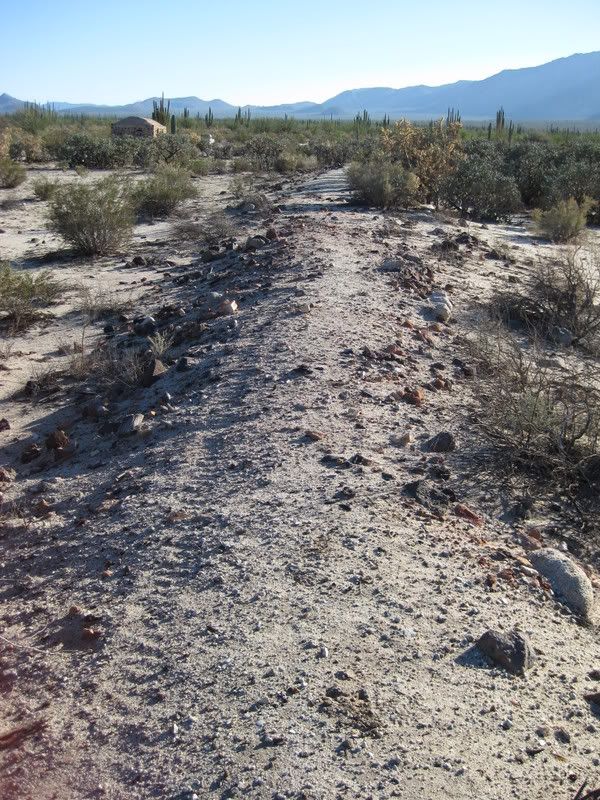
Railroad bed south to the tram line from San Juan

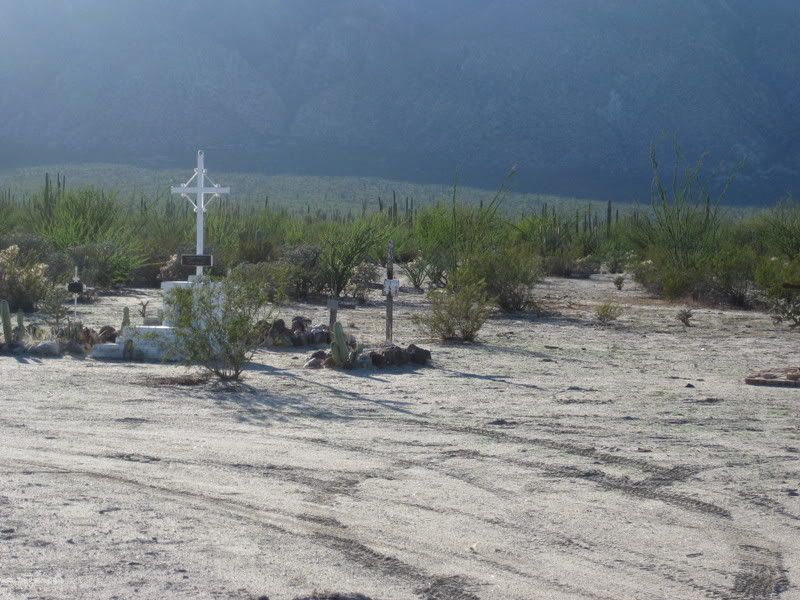

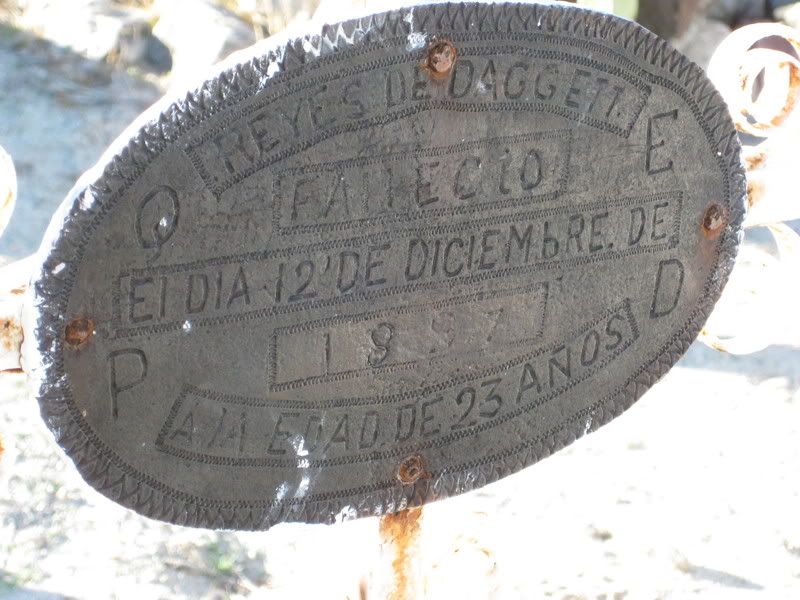
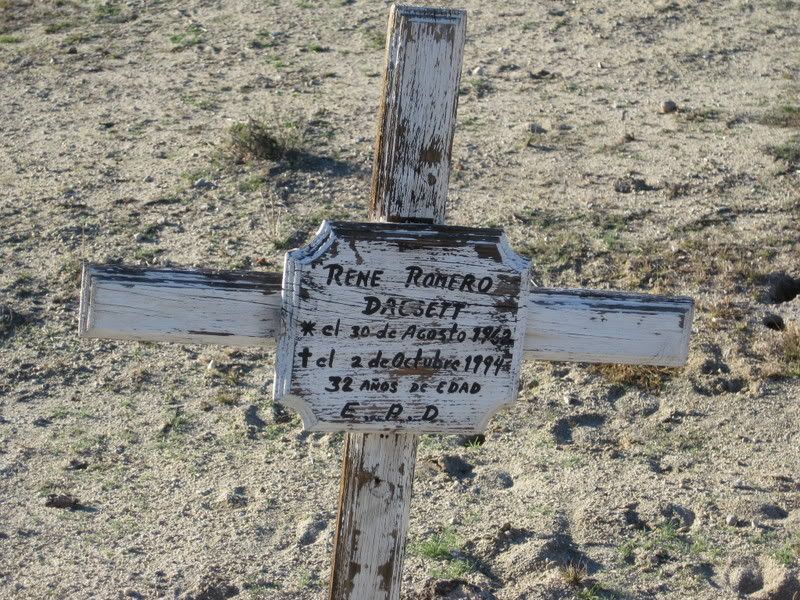
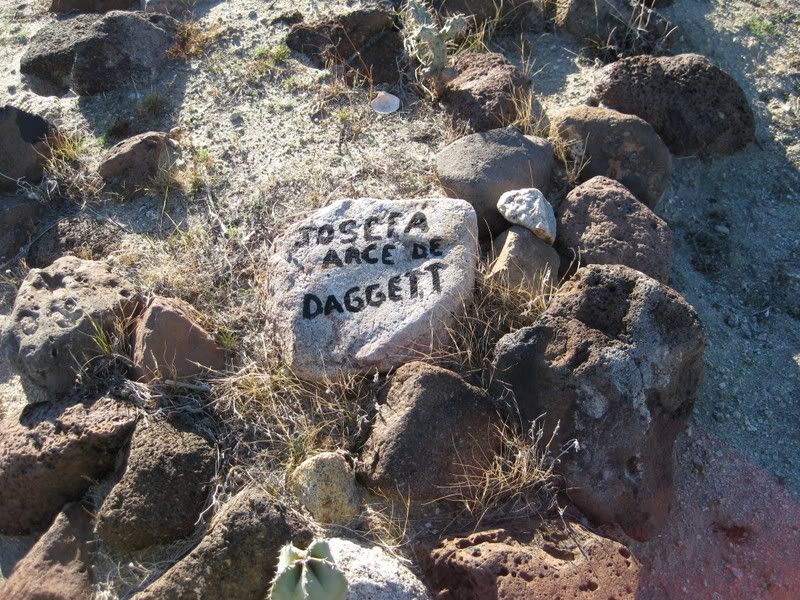

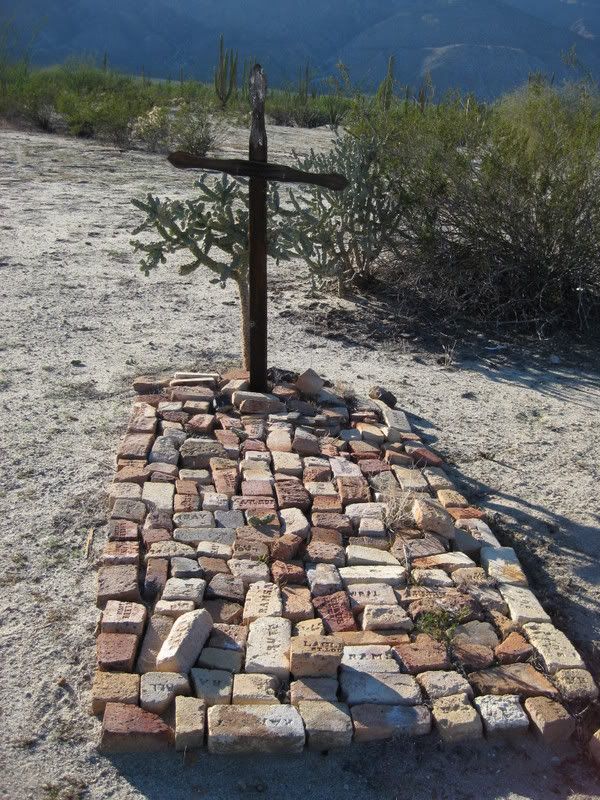
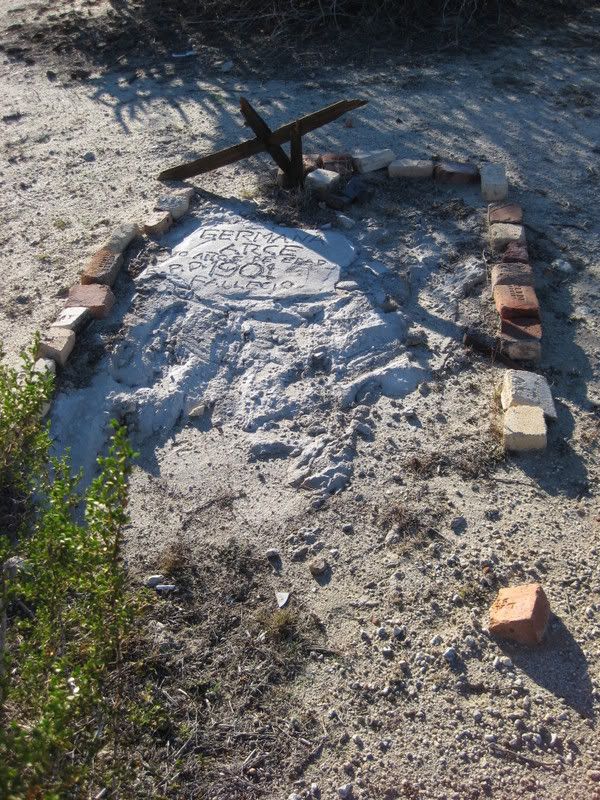

The above photos taken 3 years ago (Jan. 2, 2009)
[Edited on 1-7-2012 by David K]
|
|
|
David K
Honored Nomad
        
Posts: 65407
Registered: 8-30-2002
Location: San Diego County
Member Is Offline
Mood: Have Baja Fever
|
|
At the south end of the railroad line
Las Flores Railroad 1895-1910
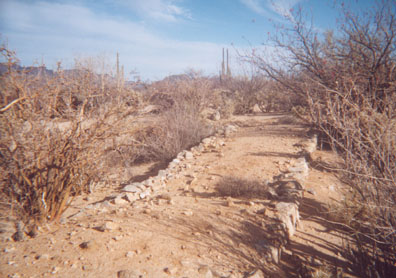
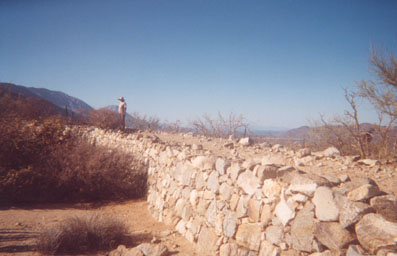

Where the ore buckets dumped into the train cars.
The giant turn-around wheel for the 2.5 mile wire rope tram was where Doc is now standing.
This large stone platform is not visible from the Jeep trail.
Park near N28°44.44' W113°32.77' and walk north.

Doc and I on Apr. 3, 2002 hiking a short distance up the canyon to see the timbers, cable, and buckets left behind by the tram line from the San Juan
mine, high atop the mountain.
A year later, I returned with my daughter for another look...

|
|
|
David K
Honored Nomad
        
Posts: 65407
Registered: 8-30-2002
Location: San Diego County
Member Is Offline
Mood: Have Baja Fever
|
|
The terminal area on Google Earth
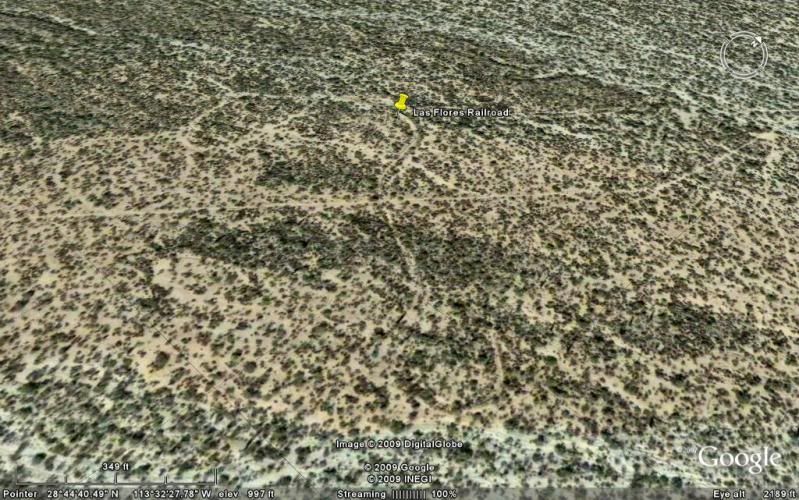

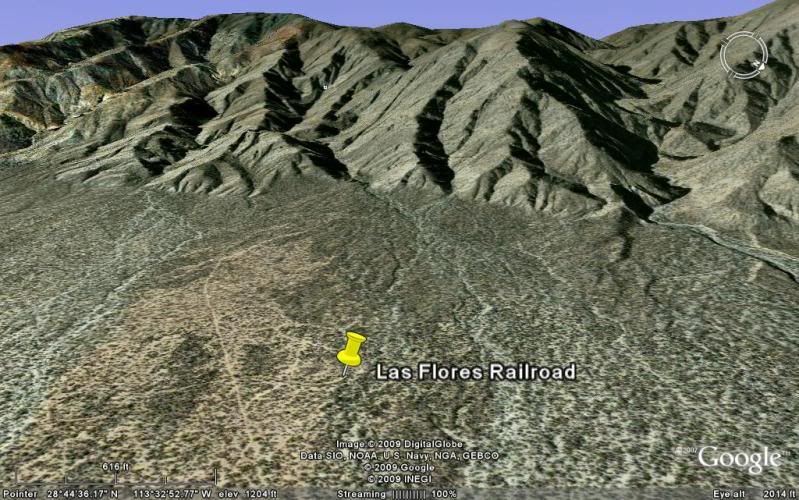
The yellow pin is on the elevated roadbed seen in the photos above.
|
|
|
willardguy
Elite Nomad
     
Posts: 6451
Registered: 9-19-2009
Member Is Offline
|
|
what are buildings with the steel doors? now this road to las flores railroad is off the la bay road? 4 wd only?
|
|
|
David K
Honored Nomad
        
Posts: 65407
Registered: 8-30-2002
Location: San Diego County
Member Is Offline
Mood: Have Baja Fever
|
|
No, it is the big graded road to San Francisquito... see the map and road log. The road from the graded road to the Terminal platform is an overgrown
Jeep trail when I last was on it... no 4WD needed.
It is 5.7 miles south from Camp Gecko's driveway, and over to your right from the graded road (the jail house)
[Edited on 3-19-2012 by David K]
|
|
|
willardguy
Elite Nomad
     
Posts: 6451
Registered: 9-19-2009
Member Is Offline
|
|
okay sorry, I got it now.
I just needed the big picture. is that really a jailhouse?
|
|
|
David K
Honored Nomad
        
Posts: 65407
Registered: 8-30-2002
Location: San Diego County
Member Is Offline
Mood: Have Baja Fever
|
|
Well, that's what everyone calls it, and there is a good story that makes sense about it... I would imagine that the ingots were kept in there between
shipments... so a dual purpose jail!
Be sure to see what I put on the Mysterious Airfield thread... I just bumped this one up after I copied the images to post where you were asking...
|
|
|
| Pages:
1
2 |
|

